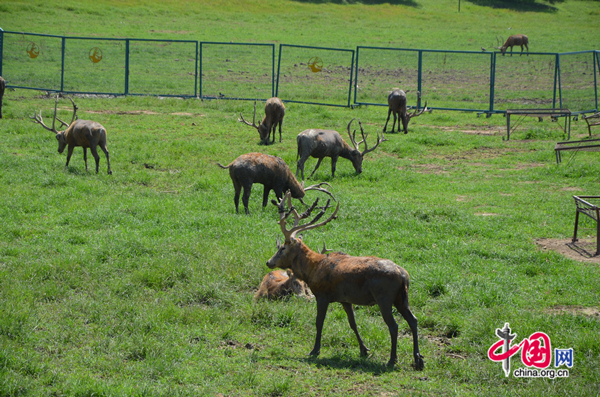The revitalization of Milu deer in China
- By Abduel Elinaza
 0 Comment(s)
0 Comment(s) Print
Print E-mail China.org.cn, August 8, 2014
E-mail China.org.cn, August 8, 2014
|
|
|
A herd of male Pere David's deer at Beijing Milu Park. [Photo by Gong Yingchun/China.org.cn] |
The name Pere David's came from the French missionary Armand David, after seeing the dear over the wall of the Imperial Hunting Park in the autumn of 1865. The animals did not survive long after that, as they were killed in a war during the reign of the Tongzhi emperor in the Qing Dynasty. Those that survived were the ones that Duke of Bedford kept in his garden.
"Thanks to our efforts, the Pere David's deer has enjoyed a healthy and colorful life in Milu Park," Mr Guo said.
In the first seven years since the reintroduction of the animal in the park, their population multiplied tenfold from 20 to slightly over 200.
Currently the park has around 200 deer. Others have been introduced to the wild, and there are now over 1,000 Pere David's deer in the wild in China.
The Milu Park is open to the public for free and it receives about a 1,000 visitors a week. During the weekend the number increases considerably.
The best time to visit the park is in summer, when Milu Park is a battlefield for the deer as is their rutting season.
The mating season begins from June to August. During this period, a strong male David's deer will dominate the female herd. The weaker males are reduced to a group of 'bachelors' and do not dare to approach the tough deer.
However, the tough deer are challenged from time to time by a bachelor who feels strong enough to overthrow the king and if successful, the ex-king will join the group of weaker ones.
Normally, since the strong or dominant male deer concentrates on mating, it will forget to eat and drink and therefore grow weaker and can easily be replaced by the next strongest one, which accumulates strength over time.
"The rutting behaviour of the male includes roaring, urine massaging, urine sniffing and so on," Mr Guo said. This process delays the multiplication of the deer. To quicken the breeding, the park, which is manned by 50 staff, introduced test tube technology --artificial insemination, in 2008.
In November 1998, the Dafeng Reserve, in east China's Jiangsu province returned eight Pere David's deer to the wild and one of the females successfully delivered a fawn in 2003.
In the same year, according to officials, the animal species was removed from the red list of endangered animals published by the World Conservation Union. However, the deer is still under high-level state protection in China.
The wetland deer species bears the odd nickname of "sibuxiang", or "unlike any of the four " for its unique features -- a horse's face, a donkey's tail, cow-like hooves and a stag's antlers.




 Add your comments...
Add your comments...

